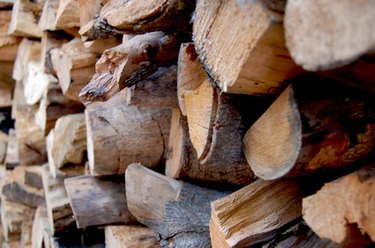
Especially in areas of the country where people maintain their own woodlots, firewood can be a sustainable fuel source. Burning wood for heat does require a reasonably efficient wood-burning stove or fireplace insert, properly seasoned logs sized to fit it and ample storage space for firewood. It also takes more effort than occasionally nudging the dial on the thermostat. Wood burners need constant tending, from bringing in firewood and feeding and stoking the fire to shoveling out wood ash. If you're serious about heating with wood, oak and other hardwoods are good firewood choices.
Firewood Basics
Video of the Day
The quality of the wood you burn as firewood makes a big difference in how efficiently you'll heat your home. Seasoned or suitably dry wood heats best. You can burn wet wood, but much of the fire's energy will be used to evaporate excess moisture rather than produce heat. Wet wood also causes flammable creosote deposits in chimneys and stove flumes, a fire safety hazard. Firewood is sold by the cord, which means a tightly packed stack of logs that's 8 feet long, 4 feet tall and 4 feet across--or any configuration that yields the same volume.
Video of the Day
Misconceptions
People think oak generates more heat than other woods. This is not strictly true. By weight, all firewood generates the same amount of heat. One lb. of any very dry wood--one with zero moisture content--generates about 8,600 British thermal units, or Btu, of heat--a Btu being the scientific measurement of the heat needed to raise the temperature of 1 lb. of water by 1 degree F. But oak usually does generate more heat per log basis--and per cord--because oak is "hard," or dense, compared with softwood, and weighs more.
Advantages
Because oak is a hardwood with greater weight and density, if properly cured and kept dry it will generate more heat when burned than softwood. Burning a cord of oak will generate substantially more heat than a cord of cured fir, for example. More importantly, if you're heating a home with wood, a firebox full of oak will generate more heat than softwood--and produce longer fires with long-lasting coal beds and radiant heat. If you'll be cutting or splitting your own firewood, oak logs split into sections easier than other hardwoods.
Disadvantages
Oak is more expensive than softwoods, though buying just-cut oak can save money. Oak takes longer to season or fully dry, too--at least one year--so if you buy more affordable green oak you'll need sunny space outdoors for it to air-dry in loose stacks. It may also be "more wood" than you need. If you primarily light special-occasion fires for the homeyness factor, a fast-burning, fragrant wood such as fir may be better. Even in cold climates, well-seasoned softwood is adequate for spring or fall.
Buying Firewood
Ask neighbors and friends for recommendations, and then shop around. Don't buy wood over the phone or otherwise sight unseen. You need to see it--and see it stacked, either before or after it's delivered--to make sure you're buying a full cord. Bring your own tape measure. Also measure log length, to make sure pieces will fit in your stove. Buy green oak in the spring--the year before you'll need it--so that you'll have more than a full year to season it.